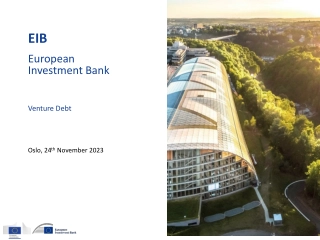The Kill Zone Impact on Venture Capital Investments
Venture capitalists are hesitant to fund startups near large digital platforms due to the Kill Zone effect. Acquisitions by giants like Google and Facebook have significant implications on innovation and investment in the digital platform world. The data reveals insights into the dynamics of early-stage investments in social media spaces, the effects of acquisitions on entry barriers, and the overall landscape of tech acquisitions.
Download Presentation

Please find below an Image/Link to download the presentation.
The content on the website is provided AS IS for your information and personal use only. It may not be sold, licensed, or shared on other websites without obtaining consent from the author.If you encounter any issues during the download, it is possible that the publisher has removed the file from their server.
You are allowed to download the files provided on this website for personal or commercial use, subject to the condition that they are used lawfully. All files are the property of their respective owners.
The content on the website is provided AS IS for your information and personal use only. It may not be sold, licensed, or shared on other websites without obtaining consent from the author.
E N D
Presentation Transcript
Kill Zone Sai Krishna Kamepalli Raghuram Rajan Luigi Zingales
Motivation Kill Zone: Venture capitalists are reluctant to fund investments in a space that is proximate to large digital platforms. The Kill Zone is a real thing. The scale of these companies [digital platforms] and their impact on what can be funded, and what can succeed, is massive : Albert Wenger, VC
Wait a minute! The prospect of being acquired should spur, not stifle, innovation and investment. What do the data say?
VC Early Stage Investments in social media space: Dollar amounts invested
Empirical Strategy 1. Identify which acquisitions are big enough to matter All Google and Facebook acquisitions > $ 500 million in the period 2006-2016 2. Identify a set of treated firms Similar to the one acquired (possibly not too similar) 3. Define a cycle-adjusted measure of investments 4. Compute this cycle-adjusted measure around acquisitions (+/- 3 years) 5. Aggregate them in an event study across acquisitions
Events All software companies acquired by Facebook or Google for more than 500 M between the beginning of 2006 and the end of 2018. Complementari ty Year Acquirer Target Price Software Sector 2006Google Youtube 1,650 Multimedia and Design Substitute 2007Google DoubleClick 3,100 Internet Complement 2009Google AdMob 750 Vertical Market Complement 2009Google Postini 625 Network Management Complement 2011Google ITA Software 676 Vertical Market Substitute 2012Facebook Instagram 1,000 Social Platform Substitute 2013Google Waze 966 Communication Substitute 2014Facebook WhatsApp 19,000 Communication Substitute 2016Google Apigee 625 Development Applications Complement
Normalized relative investment before and after an acquisition
Do acquisitions encourage entry in a digital platform world? A world characterized by: One (or a few) gigantic incumbents Network externalities: the more the customers on a platform, the more each customer benefits Switching costs for some (no costless multi-homing) Two sided platforms The price charged on one side of the platform equals zero Perhaps not!
Intuition In any acquisition, the price the entrant gets depends upon Competition among bidders Entrant s outside option to go it alone If only one large incumbent platform, there is no competition Go-it-alone value depends upon the entrant s quality the number of customers the new entrant can attract: network effects
Intuition contd. Customer decisions swayed by decisions of early adopters/app designers. In a world where early adopters/app designers have switching costs Entrant is already at a disadvantage Potential early adopters/app designers start with incumbent. Disadvantage potentially exacerbated if the authorities permit easy acquisitions
Intuition contd. Higher expectation of being acquired Depresses the number of early adopter switchers. Depresses expectations of quality and potential network externalities. Depresses number of ordinary customers who choose entrant Depresses stand-alone valuations, hence acquisition prices. Depresses investments in potential entrants
Problem in modeling Network externalities lead to multiple equilibria If I think many customers will switch, I too will switch, while if I think no one will switch, I will not switch. No relationship to fundamentals (sun spots) Similar to the modeling of bank runs Technique of global games helps us get a unique equilibrium. Equilibrium related to fundamentals. Allows us to do comparative statics.
Timeline Period 1 Period 2 Date 0 Date 1 Date 2 Techies see q and decide whether to switch based on their own switching cost Ordinary customers see techie decisions, own signal, and then decide whether to switch. Customers stay with the choices they made at date 1. Incumbent and entrant decide whether to merge and the terms thereof.
The Merger Game At date 1, the two companies decide whether to merge or not. The share of the merged value each party gets is determined through bargaining If they do merge, the superior technology will be adopted by the merged entity and all the customers will enjoy it. If the two companies do not merge, they will survive n moreperiods independently
Key result If the entrant s bargaining power is zero, her payoff is larger when mergers are prohibited, even if the prohibition on mergers leads to firms not fully exploiting the network externalities and the technological gains By continuity also true if bargaining power is sufficiently small
Key result contd. Intuition again: if mergers are prohibited, entrant will attract a greater customer base because: 1. anticipating a longer period over which they will enjoy the quality differential, a greater number of techies will switch. 2. the greater number of techies will generate a greater network externality which will attract an even greater number of ordinary customers. Since she attracts more customers when mergers are prohibited, a new entrant will generate more surplus if she stands alone than when the merger is anticipated to occur.
What Wenger says is not inconsistent with theory The data suggest it might even be plausible Different history of digital platforms in the United States, China, and the EU. EU entrants had to contend from the beginning with US incumbents, who built extensive networks in Europe early on. By contrast, Chinese entrants did not have the same problem. India and Tik Tok Less clear what authorities should do
Policy? Prohibiting mergers has problems both in theory and in practice Theory: it prevents the industry from realizing ex post efficiencies. Practice: how you define the boundaries of the prohibition A case-by-case approach will inevitably lead to approving all acquisitions However, the regulatory authorities can affect switching costs. Mandate a common standard and interoperability. All competitors realize common network externalities.
Conclusions We construct a simple model that rationalizes the existence of kill zones It depends upon the interaction of 3 frictions network externalities switching costs lack of price competition (zero lower bound) Limited evidence is consistent Not obvious how to address the problem mandated interoperability could help. The most important message: Twentieth century economic intuitions do not always translate to twenty first century economic problems























